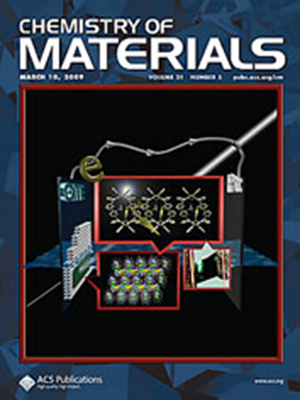具有咪唑啉羰基的双配位共价金属配合物:为有机发光二极管(OLED)实现高效蓝色热激活延迟荧光(TADF)
IF 7.2
2区 材料科学
Q2 CHEMISTRY, PHYSICAL
引用次数: 0
摘要
作为最容易获得的 N-杂环碳烯(NHC),咪唑碳烯由于其高位未占据的 π 轨道会导致暗配体间电荷转移(ICT)状态,因此传统上被排除在 TADF 合金属碳-金属-胺(CMA)配合物的设计之外。在这项工作中,通过与强电子捐赠吖啶配体合作,制备了一系列以咪唑鎓碳化物为特征的 CMA 复合物,它们表现出理想的蓝色热激活延迟荧光 (TADF),光致发光量子产率 (ΦPL)接近统一,发射衰减寿命短至 1.0 μs。S1 和 T1 之间约 100 meV 的微小能量差 (ΔEST),以及 S1 约 1 × 107-108 s-1 的高辐射衰变率,都有助于实现出色的 TADF 性能。基于 Cu(I)发射体的溶液处理蓝色有机发光二极管显示出超过 8.0% 的外部量子效率 (EQE),证明了在设计 TADF CMA 发光体时使用咪唑鎓碳化物的实用性。本文章由计算机程序翻译,如有差异,请以英文原文为准。

Two-Coordinate Coinage Metal Complexes Featuring Imidazolium Carbenes: Realization of Efficient Blue Thermally Activated Delayed Fluorescence (TADF) for Organic-Light-Emitting Diodes (OLEDs)
As the most readily accessible N-heterocyclic carbenes (NHCs), imidazolium carbenes have traditionally been ruled out for the design of TADF coinage metal carbene–metal–amine (CMA) complexes due to their high-lying unoccupied π orbitals, which lead to a dark interligand charge transfer (ICT) state. In this work, in cooperation with strong electron-donating acridine ligands, a series of CMA complexes featuring imidazolium carbenes are prepared, exhibiting desired blue thermally activated delayed fluorescence (TADF) with high photoluminescent (PL) quantum yields (ΦPL) close to unity and emission decay lifetimes as short as 1.0 μs. The small energy differences between S1 and T1 (ΔEST) of around 100 meV and the high radiative decay rates of S1 on the order of 1 × 107–108 s–1 contribute to the decent TADF behavior. Solution-processed blue OLEDs based on the Cu(I) emitter show an external quantum efficiency (EQE) exceeding 8.0%, demonstrating the practicality of using imidazolium carbenes in the design of TADF CMA luminophores.
求助全文
通过发布文献求助,成功后即可免费获取论文全文。
去求助
来源期刊

Chemistry of Materials
工程技术-材料科学:综合
CiteScore
14.10
自引率
5.80%
发文量
929
审稿时长
1.5 months
期刊介绍:
The journal Chemistry of Materials focuses on publishing original research at the intersection of materials science and chemistry. The studies published in the journal involve chemistry as a prominent component and explore topics such as the design, synthesis, characterization, processing, understanding, and application of functional or potentially functional materials. The journal covers various areas of interest, including inorganic and organic solid-state chemistry, nanomaterials, biomaterials, thin films and polymers, and composite/hybrid materials. The journal particularly seeks papers that highlight the creation or development of innovative materials with novel optical, electrical, magnetic, catalytic, or mechanical properties. It is essential that manuscripts on these topics have a primary focus on the chemistry of materials and represent a significant advancement compared to prior research. Before external reviews are sought, submitted manuscripts undergo a review process by a minimum of two editors to ensure their appropriateness for the journal and the presence of sufficient evidence of a significant advance that will be of broad interest to the materials chemistry community.
 求助内容:
求助内容: 应助结果提醒方式:
应助结果提醒方式:


